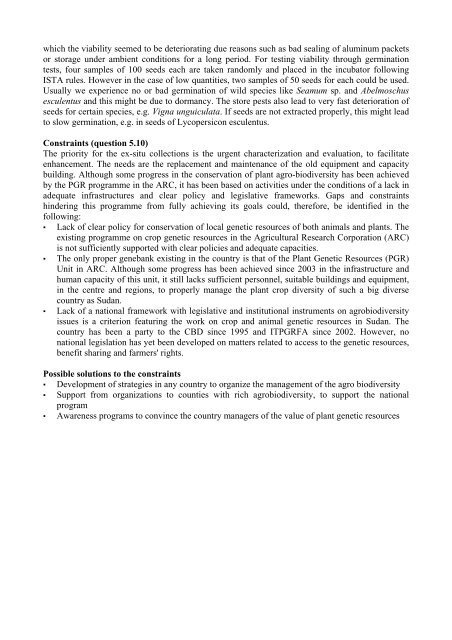Improving the identification, handling and storage of âdifficultâ seeds ...
Improving the identification, handling and storage of âdifficultâ seeds ...
Improving the identification, handling and storage of âdifficultâ seeds ...
You also want an ePaper? Increase the reach of your titles
YUMPU automatically turns print PDFs into web optimized ePapers that Google loves.
which <strong>the</strong> viability seemed to be deteriorating due reasons such as bad sealing <strong>of</strong> aluminum packets<br />
or <strong>storage</strong> under ambient conditions for a long period. For testing viability through germination<br />
tests, four samples <strong>of</strong> 100 <strong>seeds</strong> each are taken r<strong>and</strong>omly <strong>and</strong> placed in <strong>the</strong> incubator following<br />
ISTA rules. However in <strong>the</strong> case <strong>of</strong> low quantities, two samples <strong>of</strong> 50 <strong>seeds</strong> for each could be used.<br />
Usually we experience no or bad germination <strong>of</strong> wild species like Seamum sp. <strong>and</strong> Abelmoschus<br />
esculentus <strong>and</strong> this might be due to dormancy. The store pests also lead to very fast deterioration <strong>of</strong><br />
<strong>seeds</strong> for certain species, e.g. Vigna unguiculata. If <strong>seeds</strong> are not extracted properly, this might lead<br />
to slow germination, e.g. in <strong>seeds</strong> <strong>of</strong> Lycopersicon esculentus.<br />
Constraints (question 5.10)<br />
The priority for <strong>the</strong> ex-situ collections is <strong>the</strong> urgent characterization <strong>and</strong> evaluation, to facilitate<br />
enhancement. The needs are <strong>the</strong> replacement <strong>and</strong> maintenance <strong>of</strong> <strong>the</strong> old equipment <strong>and</strong> capacity<br />
building. Although some progress in <strong>the</strong> conservation <strong>of</strong> plant agro-biodiversity has been achieved<br />
by <strong>the</strong> PGR programme in <strong>the</strong> ARC, it has been based on activities under <strong>the</strong> conditions <strong>of</strong> a lack in<br />
adequate infrastructures <strong>and</strong> clear policy <strong>and</strong> legislative frameworks. Gaps <strong>and</strong> constraints<br />
hindering this programme from fully achieving its goals could, <strong>the</strong>refore, be identified in <strong>the</strong><br />
following:<br />
▪ Lack <strong>of</strong> clear policy for conservation <strong>of</strong> local genetic resources <strong>of</strong> both animals <strong>and</strong> plants. The<br />
existing programme on crop genetic resources in <strong>the</strong> Agricultural Research Corporation (ARC)<br />
is not sufficiently supported with clear policies <strong>and</strong> adequate capacities.<br />
▪ The only proper genebank existing in <strong>the</strong> country is that <strong>of</strong> <strong>the</strong> Plant Genetic Resources (PGR)<br />
Unit in ARC. Although some progress has been achieved since 2003 in <strong>the</strong> infrastructure <strong>and</strong><br />
human capacity <strong>of</strong> this unit, it still lacks sufficient personnel, suitable buildings <strong>and</strong> equipment,<br />
in <strong>the</strong> centre <strong>and</strong> regions, to properly manage <strong>the</strong> plant crop diversity <strong>of</strong> such a big diverse<br />
country as Sudan.<br />
▪ Lack <strong>of</strong> a national framework with legislative <strong>and</strong> institutional instruments on agrobiodiversity<br />
issues is a criterion featuring <strong>the</strong> work on crop <strong>and</strong> animal genetic resources in Sudan. The<br />
country has been a party to <strong>the</strong> CBD since 1995 <strong>and</strong> ITPGRFA since 2002. However, no<br />
national legislation has yet been developed on matters related to access to <strong>the</strong> genetic resources,<br />
benefit sharing <strong>and</strong> farmers' rights.<br />
Possible solutions to <strong>the</strong> constraints<br />
▪ Development <strong>of</strong> strategies in any country to organize <strong>the</strong> management <strong>of</strong> <strong>the</strong> agro biodiversity<br />
▪ Support from organizations to counties with rich agrobiodiversity, to support <strong>the</strong> national<br />
program<br />
▪ Awareness programs to convince <strong>the</strong> country managers <strong>of</strong> <strong>the</strong> value <strong>of</strong> plant genetic resources

















